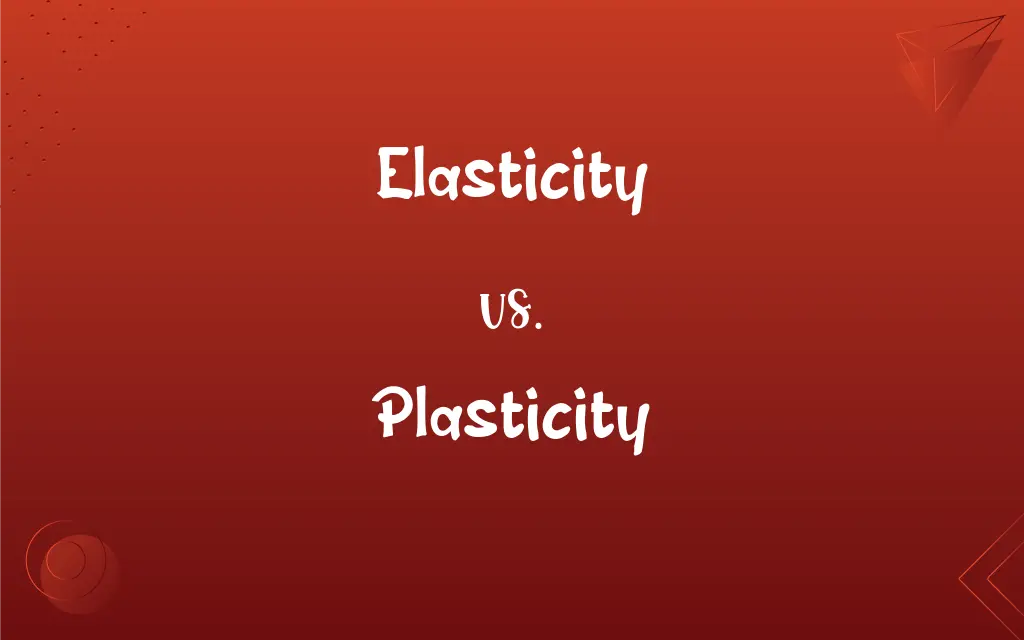Elasticity vs. Plasticity: What's the Difference?
Edited by Harlon Moss || By Aimie Carlson || Published on November 26, 2023
Elasticity is the ability of a material to return to its original shape after deformation, while plasticity is the permanent deformation of a material under stress.

Key Differences
Elasticity refers to a material's capacity to regain its original form after being stretched or compressed. Plasticity, on the other hand, is the tendency of a material to undergo permanent deformation when subjected to external forces.
Materials with high elasticity, like rubber, can endure significant stretching and still return to their original shape. In contrast, plastic materials, such as clay, retain the shape they are molded into and do not revert to their original form.
The concept of elasticity is central in applications where flexibility and resilience are crucial, like in springs and elastic bands. Plasticity is key in processes like forging and sculpting, where permanent shaping of materials is desired.
The recovery of elastic materials from deformation is due to their internal molecular forces. Plastic deformation, however, involves a reorganization of the material's molecular structure, resulting in a lasting change.
In elasticity, the deformation is temporary and the material behaves like a spring, following Hooke's law up to a limit. In plasticity, the deformation is permanent and the material does not conform to Hooke's law beyond its yield point.
ADVERTISEMENT
Comparison Chart
Definition
Ability to return to original shape after stress.
Permanent deformation under stress.
Deformation Type
Temporary and reversible.
Permanent and irreversible.
Material Behavior
Returns to original shape after stress is removed.
Retains new shape even after stress is removed.
Molecular Change
No permanent molecular change.
Permanent molecular reorganization.
Example Applications
Springs, elastic bands.
Sculpting, metal forging.
ADVERTISEMENT
Elasticity and Plasticity Definitions
Elasticity
Elasticity is the property of material to recover its original shape after deformation.
A rubber band exhibits elasticity when it returns to its original shape after being stretched.
Plasticity
Plasticity is the ability of a material to undergo permanent deformation.
The plasticity of clay makes it ideal for pottery, as it retains its shaped form after molding.
Elasticity
The ability of a material to resist and recover from deformation.
The elasticity of a spring allows it to return to its initial length after being compressed.
Plasticity
A characteristic of materials that do not return to their original shape after stress.
The plasticity of earthen materials is essential in brick-making.
Elasticity
Elasticity is the measure of a material's flexibility.
The high elasticity of a yoga mat enables it to regain shape after being rolled up.
Plasticity
The property of materials to maintain a changed shape after force application.
The plasticity of metals is exploited in forging processes to shape tools and components.
Elasticity
The reversible deformability of materials under stress.
Elastic fibers in clothing maintain elasticity, providing comfort and fit.
Plasticity
Plasticity refers to the permanent deformation of a material under stress.
Plastic deformation is observed in metals when they are bent or hammered into new shapes.
Elasticity
Elasticity refers to a material's ability to withstand stress without permanent deformation.
The elasticity of a car tire is crucial for absorbing impacts without deforming.
Plasticity
The quality of a material to be molded or altered permanently.
Plasticity in dough allows bakers to shape it into various forms.
Elasticity
The condition or property of being elastic; flexibility.
Plasticity
Capable of being shaped or formed
Plastic material such as clay.
Elasticity
The property of returning to an initial form or state following deformation.
Plasticity
Relating to or dealing with shaping or modeling
The plastic art of sculpture.
Elasticity
The degree to which this property is exhibited.
Plasticity
Having the qualities of sculpture; well-formed
"the astonishing plastic beauty of the chorus girls" (Frank Harris).
Elasticity
A measure of how changes in price affect supply or demand for a given good, equal to the percentage of change in supply or demand divided by the percentage of the price change.
Elasticity
(physics) The property by virtue of which a material deformed under load can regain its original dimensions when unloaded
Elasticity
(economics) The sensitivity of changes in a quantity with respect to changes in another quantity.
If the sales of an item drop by 5% when the price increases by 10%, its price elasticity is −0.5.
Elasticity
(computing) A measure of the flexibility of a data store's data model and clustering capabilities.
Elasticity
(computing) A system's ability to adapt to changes in workload by automatically provisioning and de-provisioning resources.
Elasticity
(mathematics) The ratio of the relative change in a function's output with respect to the relative change in its input, for infinitesimal changes at a certain point.
Elasticity
The quality of being elastic.
Elasticity
Adaptability.
Her elasticity allowed her to recover quickly.
Elasticity
The quality of being elastic; the inherent property in bodies by which they recover their former figure or dimensions, after the removal of external pressure or altering force; springiness; resilience; tendency to rebound; as, the elasticity of caoutchouc; the elasticity of the air.
Elasticity
Power of resistance to, or recovery from, depression or overwork; - usually referred to as resilience[3].
Elasticity
The tendency of a body to return to its original shape after it has been stretched or compressed;
The waistband had lost its snap
FAQs
What defines a material's elasticity?
Its ability to return to its original shape after being deformed.
What is plasticity in materials?
The ability to undergo permanent deformation under stress.
How is plasticity used in industry?
In manufacturing processes like metal forging and clay molding.
Can materials be both elastic and plastic?
Yes, some materials exhibit both properties, depending on the stress applied.
What is an example of elasticity?
A rubber band stretching and returning to its original size.
Does temperature affect plasticity?
Yes, higher temperatures can increase the plasticity of materials.
What is a practical application of plasticity?
The shaping of metals in automotive bodywork.
Can elasticity be measured?
Yes, using parameters like Young's modulus.
Can the plasticity of a material change over time?
Yes, due to factors like aging, wear, and environmental conditions.
What role does plasticity play in construction?
It's important for materials like concrete and asphalt in molding and setting.
What causes elasticity in materials?
The intermolecular forces that allow materials to resume their shape.
Are elastic materials always soft?
No, some hard materials, like steel, can also exhibit elasticity.
Does plasticity imply a material is weak?
Not necessarily; it relates to deformability, not strength.
Is the elasticity of a material permanent?
Yes, as long as the material's elastic limit is not exceeded.
How does plasticity benefit sculpture?
It allows sculptors to shape materials like clay into lasting forms.
Is rubber an example of a highly elastic material?
Yes, rubber is known for its high elasticity.
Can all metals show plasticity?
Most metals do, but the degree of plasticity varies among different types.
Are there limits to a material's elasticity?
Yes, exceeding the elastic limit can lead to permanent deformation.
How is plasticity important in material science?
It's crucial for understanding how materials can be shaped and used in various applications.
Is elasticity a factor in material selection for springs?
Absolutely, as springs require materials with high elasticity for effective operation.
About Author
Written by
Aimie CarlsonAimie Carlson, holding a master's degree in English literature, is a fervent English language enthusiast. She lends her writing talents to Difference Wiki, a prominent website that specializes in comparisons, offering readers insightful analyses that both captivate and inform.
Edited by
Harlon MossHarlon is a seasoned quality moderator and accomplished content writer for Difference Wiki. An alumnus of the prestigious University of California, he earned his degree in Computer Science. Leveraging his academic background, Harlon brings a meticulous and informed perspective to his work, ensuring content accuracy and excellence.


































































